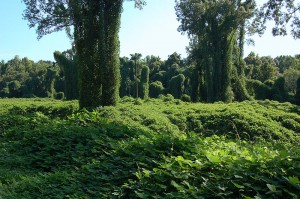
Pueraria montana
Native range: Asia
Invasive range: Common throughout most of the Southeast and has been found as far north as North Dakota and Orgeon.
Description: Perennial woody vine. Aggressive climber. Alternate and compound leaves, typically with three broad leaflets. Purple flowers, highly fragrant.
Kudzu was first brought to the U.S. by Japan, which promoted it as an ornamental and as a forage crop at the 1876 Centennial Exposition in Philadelphia. By 1900, its fragrant grape-scented purple flowers and the vine’s ability seemingly to cover a trellis in a night had made it popular on porches throughout the Southeastern US. Despite the warning of a visionary biologist named David Fairchild in 1902 that this vine could become something new to the scientific community, an “invasive species,” kudzu was planted through the South, first as livestock feed, then as erosion control along highways. Farmers were paid to plant the stuff in the 1940s.
In 1953, the federal government stopped advocating the planting of kudzu, and the USDA declared it a weed in 1972. Kudzu had outgrown the farms raising it and gone wild, smothering forests, parkland, or yards in its path, earning itself the name the Vine That Ate the South. You don’t achieve the status of weed by being hard to grow or easy to kill. You take millions of acres without breaking a sweat.
A 2020 study suggested that the costs of kudzu in just one state could be about $168 million per year. About 800 Oklahomans could lose their jobs in the forest product industry, where kudzu costs about $250 an acre to control each year.
But recently the story took a fascinating turn. Invasives often thrive in the absence of native predators, competitors, or parasites. In 2009, what’s been dubbed the kudzu bug was identified in the South, a brand new invader from Asia. It eats kudzu–joy of joys–but that’s not all it eats. It devours soybeans, too, a huge moneymaker of a crop. What’s the solution?

Kudzu Blossom Sorbet
José Gutierrez, Chez Philippe, Memphis, Tennessee
Serves 4
2 cups dry white wine
2 cups water
13/4 cups sugar
2 cups kudzu blossoms
1 ounce licorice root, minced
1 pinch cayenne pepper
Place the wine, water, and sugar in a saucepan and bring to a boil. When this is boiling, add the kudzu blossoms, licorice root, and cayenne pepper and boil for 1 minute more. Remove from the heat and set aside to cool. Cover the pan with plastic wrap and leave overnight to infuse the flavors. The next day, strain the mixture, place it in an ice cream maker, and process according to the manufacturer’s directions. For those without an ice cream maker: Transfer the strained mixture to a glass baking dish. Freeze the mixture until firm, stirring occasionally, for about five hours. Break the sorbet into large pieces and purée it in a food processor until smooth and creamy. Cover and freeze until firm. Let the sorbet stand at room temperature for 5 minutes before serving.
Recipes and Beyond
Ayurella Horn-Muller writes about efforts by artists, designers, and chefs to make kudzu useful in Southerly Magazine.
SouthernAngel’s kudzu recipes, including blossom jelly, quiche, and deep-fried leaves.
Grandpappy’s recipes, including root tea, salad, and blossoms.



























{ 4 comments… read them below or add one }
I say we should allow said bug to destroy the invasive Soybean plant. We should eliminate the poisonous unfermented soybean from our diets!
wonder any KUDZU farm in Oregon State?
More people on earth prefer goat, rather than any other red meat. Goat meat is very low in cholesterol and tastes great. They are more cost effective to produce than cattle or sheep and they love Kudzu. Goats will eat probably more varieties of plants than they would refuse. Kudzu can be killed by injecting Helium gas into the ground beside the root system. Kudzu can also be used make biofuel and is ideal for production of methane via a biogas composting tank. There is absolutely no reason why it could not be used for silage. It can even be used for basket weaving if that ‘floats your boat’. The list goes on, however this should get you thinking instead ‘bitching’. The main point is that it does not need vast quantities of chemicals, heavy machinery, or Herculean human input to control. The least effective manner of control is ‘whining’ about it being a problem.
Thanks for the recommendation via Twitter! Great site
{ 5 trackbacks }